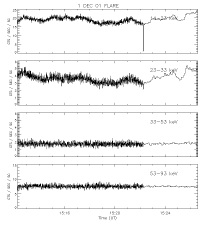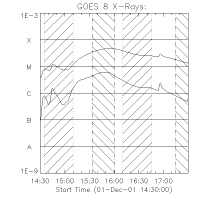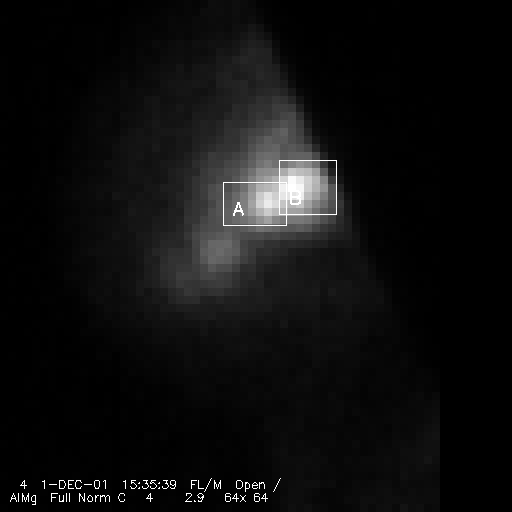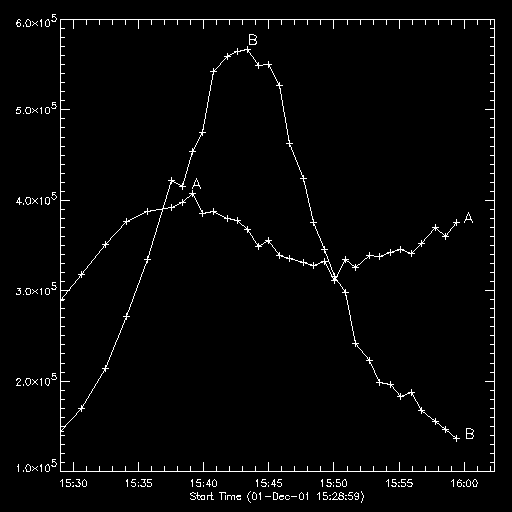

In this week, we have studied a flare which occurred above the solar limb on 1-dec-01. This "long-duration event" flare (alternatively, "long-decay event" or LDE) reached an intensity of M4.8 in the GOES classification. Some interesting flares above the limb have been reported in previous nuggets ([1], [2]). Here, we report on two motions that were observed in soft X-rays. One is a downward motion of the bright core located at a loop-top and the other is an apparent loop shrinkage. Both are quite uncommon.
GOES and Hard X-ray time profiles
Yohkoh was in the SAA around the peak time (~15:50 UT), but we did get some data during this interval (see below). Hard X-ray intensity (from HXT) shows gradual intensity behavior in L (14-23 keV) and M1 (23-33 keV) energy channels. The temperature derived from a ratio of the L/M1 signals is about 31 MK during this time. The lower-energy X-ray intensity seen by GOES shows smooth evolution in both low (1-8 angstrom) and high (0.5-4 angstrom) channels.
Evolution of soft X-ray images
In the current setup for SXT flare observations, the soft X-ray images are made with 2 different analysis filters. The images and movies shown on this page all come from the Al/Mg/Mn sandwich filter, though the beryllium filter was also used. The two images immediately below show the appearance of the flare before and after the peak time. The brightest area moved from the north towards the south region.
Motions
Here, we prepared three movies to see motion observed in soft X-rays; all the movies are from the SXT PFIs. Each image is composed of 64X64 pixels, with a pixel size of about 2.45 arcseconds. Also, in order to see a variation of intensity, all images are normalized by a standard value. When you see this movie, you'll see two distinct motions. First motion is the change of the soft X-ray brightest position. We frequently see motion in which the brightest position increases in height. However, in this case, the height is decreasing! The bright source moves downward from about 15:30 UT to 15:40 UT as seen in the movie. The speed of this downward motion is about 10 KM/s. Also, you can see a motion which seems to be a loop shrinkage in the last movie.
The second movie is almost same as first one. But, each image is individually normalized within each map (i.e., there is not a single standard brightness for the whole movie). It may be more clear to see the change of the brightest position in each time.
In the last movie, faint structures have been enhanced and therefore it is easier to see motion of a loop, which starts in the edge of the bright area located in the north region. The motion seems to be a loop shrinkage. After the shrinkage, the brightness in the south region seems to increase (not so clear in this movie). Therefore, this shrinkage may be related to the change of brightest area described in Introduction.
Real Motions?
If the source exists without surrounding structure and it changes its position as time goes, we'll say easily that 'A source moved'. However, a bright source is frequently related to the surrounding structure, i.e., background component. Therefore, if the background component shows intensity variation, a source may seem to move due to this variation. Below, we plot intensity time profiles (right panel) of two regions shown as box A and B (left panel). These A and B regions include the region which shows a downward motion. From this plot, we see a peak (~15:38) in region A, which is followed by another peak in region B. Also, total flux in region B is higher than that of region A. Therefore, the sources observed in region A and B are not completely the same although these sources are closely related to each other.

|

|
Conclusion
We have seen two kinds of motions in soft X-rays. Especially, a downward motion is very interesting. Such a downward motion is already reported by D. McKenzie (Solar Physics, v. 195, Issue 2 p.381-399). However, this source is not same as one reported in the above paper, since it shows very bright intensity, and the speed is very low. A detailed study will be done with the surrounding structure.